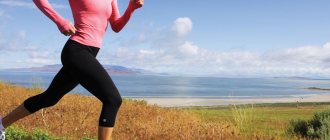Human energy consumption and food intake[edit | edit code]
Main article: Metabolic adaptation to weight loss: implications for the athlete
Energy consumption of human muscles, organs and tissues depending on gender, age category and body weight Table of energy consumption of human organs and tissues
Total daily energy expenditure of a person
consists of a number of individual components. The largest component is energy expenditure at rest, this is energy expenditure on basal (basic) metabolism[1]. Another component is energy expenditure during activity. It in turn can be divided into:
- energy expenditure for thermogenesis during sports exercise
- energy expenditure for thermogenesis during non-exercise activities
- energy loss due to the thermic effect of food
Metabolic rate
– dynamic quantity. Energy deficiency in the body and weight loss affect the body's energy metabolism. In particular, with active reduction of body weight, the total daily energy expenditure of a person decreases. In addition, weight loss reduces the volume of tissue involved in metabolism, and thereby reduces the overall metabolic rate[2][3].
Often, the amount by which total daily energy expenditure is reduced is greater than that calculated based on the amount by which total body weight is reduced. In a number of studies, this fact is explained by the body’s desire to restore normal (basic) body weight [4][5][6]. It is adaptive thermogenesis that can explain the occurrence of a plateau in weight loss, as well as the body’s predisposition to weight gain after stopping the diet.
Energy consumption during various physical activities
In addition, when body weight is reduced, the level of thermogenesis during exercise decreases[7][8][9]. Obviously, for activities that require movement of the body, reducing total body mass will reduce the amount of energy required to perform the exercise. However, if an athlete uses weights to increase his weight to the original weight, the energy consumption for performing the exercise remains lower than it was before the reduction in body weight. It is assumed that this increase in muscle efficiency may be associated with hypothyroidism and hypoleptinemia, which accompany weight loss, which leads to a decrease in the respiratory quotient and an increase in the proportion of lipid metabolism [10].
Thermic effect of food
includes energy costs for food intake, absorption, metabolism and nutrient storage[11]. The thermic effect of food accounts for approximately 10% of total daily energy expenditure[12][13]. This proportion may vary depending on the type of diet. At the same time, the relative magnitude of the thermic effect of food does not change during energy deficiency in the body [14], despite the fact that with a low-calorie diet, naturally, the absolute value of the thermic effect of food will be lower than with a regular diet.
Energy expenditure for non-exercise activities
(daily activity) also decrease with the onset of energy deficiency[15]. There is evidence that the level of spontaneous physical activity decreases with a general energy deficit in the body, and may remain reduced for some time even after a return to normal food intake[16]. This factor may also contribute to weight gain after stopping a special diet. In general, to effectively reduce body weight, the level of energy intake must be determined based on individual energy expenditure during the day. In the context of weight loss, this process is complicated by the fact that energy expenditure is dynamic throughout the day. During weight loss, there is often a decrease in total energy expenditure (including energy expenditure during exercise and non-exercise activities), as well as overall metabolic rate and energy expenditure due to the thermic effect of food. As a result of the initiation of the process of adaptive thermogenesis, total energy expenditure is reduced by an amount greater than can be predicted based on the observed decrease in body weight. At the same time, the process of adaptive thermogenesis, as well as a decrease in total energy expenditure, is observed even after the cessation of active weight loss [17] [18]. These changes are due to the body's desire to minimize energy deficit, as well as prevent further weight loss.
To obtain ATP from energy substrates, the body requires a series of chemical reactions. In the case of aerobic metabolism, this process involves the movement of protons across the inner mitochondrial membrane. With the help of ATP synthase, the energy of protons is directed to the synthesis of ATP. At the same time, protons can leak through the inner membrane via uncoupling proteins (UCPs)[19]. In this case, oxygen consumption and oxidation of energy substrates occur, but ATP synthesis does not occur. Proton leakage is a fairly significant factor in the body’s energy consumption. For example, in rats it can account for 20-30% of the total energy expenditure for metabolism [20][21][22].
Obese people have lower amounts of brown fat and a reduced metabolic rate in brown fat cells. This has been shown to be associated with increased serotonin concentrations in peripheral tissues, including adipose tissue. Serotonin reduces energy expenditure and, as a result, can lead to obesity and diabetes.[23]
Features of nutrition at a distance during long runs (20 km or more)
During long runs, the body not only uses up energy reserves, but also loses electrolytes through sweat. Large losses of water lead to thickening of the blood and hemodynamic disturbances, which results in a sharp decrease in performance and the development of symptoms of fatigue during running or after the end of the distance. Therefore, to prevent excessive fatigue at a distance, special nutrition is necessary. At distances of 15-20 km, you can, especially in hot weather, drink ordinary clean water to prevent blood thickening and decreased performance. For longer runs, it is necessary to consume special nutritional mixtures in the form of drinks.
Table of energy consumption for various types of activities[edit | edit code]
To find out your energy consumption, you need to multiply the coefficient by your weight and the duration of physical activity.
For example, a person weighing 80 kg in 30 minutes. intense aerobics will spend: 0.123 x 80 (kg) x 30 (min) = 295.2 kilos
calories.
| Sport | kcal/min*kg |
| archery | 0.062 |
| badminton | 0.079 |
| basketball | 0.114 |
| billiards | 0.0439 |
| Mountain bike | 0.15 |
| bike 20 km/h | 0.1409 |
| bike 25 km/h | 0.1759 |
| bike 30 km/h | 0.211 |
| bike 35+ km/h | 0.1409 |
| skittles | 0.053 |
| boxing | 0.158 |
| curling | 0.07 |
| fast dancing | 1.06 |
| slow dancing | 0.053 |
| fencing | 0.106 |
| American football | 0.158 |
| golf | 0.097 |
| handball | 0.211 |
| walking in nature | 0.106 |
| hockey | 0.1409 |
| horseback riding | 0.07 |
| kayaking | 0.0879 |
| martial arts | 0.1759 |
| terrain orientation | 0.158 |
| race walking | 0.114 |
| racquetball | 0.123 |
| mountaineering (climbing) | 0.194 |
| roller skating | 0.123 |
| rope jumping | 0.1759 |
| running 8.5 km/h | 0.1409 |
| running 10 km/h | 0.1759 |
| running 15 km/h | 0.255 |
| running in nature | 0.158 |
| cross-country skiing | 0.1409 |
| skiing from the mountains | 0.106 |
| luge | 0.123 |
| snorkeling | 0.0879 |
| football | 0.123 |
| softball | 0.0879 |
| swimming (general) | 0.106 |
| fast swimming | 0.1759 |
| backstroke | 0.1409 |
| swimming (breaststroke) | 0.1759 |
| swimming (butterfly) | 0.194 |
| swimming (crawl) | 0.194 |
| tennis | 0.123 |
| volleyball (game) | 0.053 |
| volleyball (competition) | 0.07 |
| Beach volleyball | 0.1409 |
| walking 6 km/h | 0.07 |
| walking 7 km/h | 0.079 |
| walking 8 km/h | 0.0879 |
| fast walk | 0.106 |
| water skiing | 0.106 |
| water polo | 0.1759 |
| water volleyball | 0.053 |
| struggle | 0.106 |
| Labor activity | kcal/min*kg |
| work as a bartender | 0.0439 |
| work as a carpenter | 0.062 |
| work as a sports trainer | 0.07 |
| work as a miner | 0.106 |
| working at the computer | 0.024 |
| Construction | 0.097 |
| work as a clerk | 0.031 |
| work as a fireman | 0.211 |
| work as a forester | 0.1409 |
| work as a heavy machine operator | 0.0439 |
| heavy hand tools | 0.1409 |
| horse care | 0.106 |
| office work | 0.0206 |
| work as a mason | 0.123 |
| work as a massage therapist | 0.07 |
| police work | 0.0439 |
| studying in class | 0.031 |
| steelworker job | 0.1409 |
| work as an actor in the theater | 0.053 |
| truck driver job | 0.035 |
| Fitness, aerobics | kcal/min*kg |
| light aerobics | 0.097 |
| aerobics intense | 0.123 |
| easy step aerobics | 0.123 |
| step aerobics intensive | 0.1759 |
| water aerobics | 0.7 |
| cycling trainer (medium activity) | 0.123 |
| cycling trainer (high activity) | 0.185 |
| rhythmic gymnastics (heavy) | 0.1409 |
| rhythmic gymnastics (easy) | 0.079 |
| rider-type exercise equipment | 0.0879 |
| rowing machine (medium activity) | 0.123 |
| ski simulator | 0.167 |
| stretching (hatha yoga) | 0.07 |
| lifting weights | 0.053 |
| intense weight lifting | 0.106 |
| Work in the country | kcal/min*kg |
| gardening (general) | 0.079 |
| wood chopping | 0.106 |
| digging holes | 0.0879 |
| stacking and carrying firewood | 0.0879 |
| work in the garden (weeding) | 0.081 |
| laying turf | 0.0879 |
| working with a lawn mower | 0.079 |
| planting in the garden | 0.07 |
| tree planting | 0.079 |
| rake work | 0.07 |
| cleaning leaves | 0.07 |
| manual snow removal | 0.106 |
| Housework | kcal/min*kg |
| baby care (bathing, feeding) | 0.062 |
| children's games | 0.0879 |
| Cooking | 0.0439 |
| grocery shopping | 0.062 |
| heavy cleaning | 0.079 |
| Moving furniture | 0.106 |
| moving boxes | 0.123 |
| unpacking boxes | 0.062 |
| playing with a child (moderate activity) | 0.07 |
| car repair | 0.053 |
| carpentry work | 0.106 |
| furniture repair | 0.079 |
| drain cleaning | 0.0879 |
| laying carpet or tiles | 0.079 |
| roofing | 0.106 |
| wiring | 0.053 |
Daily energy expenditure
What sport do you like to play? Hiking, swimming, aerobics or water aerobics, cycling or rollerblading, strength exercises? Or maybe you prefer something calmer and more relaxing - yoga or breathing exercises? Or are you attracted to dancing? They are slow and energetic - for every taste, for any age, for any state of mind. The main thing is to choose an activity that will become a source of joy, and to train regularly, that is, at least for an hour at least once or twice a week. This will balance daily energy expenditure and normalize metabolism in the body.
Learn to derive pleasure not from food, but from physical activity. It has been proven that it enhances the production of happiness hormones no worse, but much better, than chocolate and other high-calorie sweets. Mobile people even have a different facial expression: they feel the fullness of life. Food is the most primitive source of positive emotions. Let's not be primitive people!
Sources[edit | edit code]
- Maclean PS, Bergouignan A, Cornier MA, Jackman MR: Biology's response to dieting: the impetus for weight regain. Am J Physiol Regul Integr Comp Physiol 2011, 301:R581-R600.https://www.ncbi.nlm.nih.gov/pubmed/21677272?dopt=Abstract&holding=f1000,f1000m,isrctn
- Ravussin E, Burnand B, Schutz Y, Jequier E: Energy expenditure before and during energy restriction in obese patients. Am J Clin Nutr 1985, 41:753-759. https://www.ncbi.nlm.nih.gov/pubmed/3984927?dopt=Abstract&holding=f1000,f1000m,isrctn
- Leibel RL, Rosenbaum M, Hirsch J: Changes in energy expenditure resulting from altered body weight. N Engl J Med 1995, 332:621-628. https://www.ncbi.nlm.nih.gov/pubmed/7632212?dopt=Abstract&holding=f1000,f1000m,isrctn
- Doucet E, St-Pierre S, Almeras N, Despres JP, Bouchard C, Tremblay A: Evidence for the existence of adaptive thermogenesis during weight loss. Br J Nutr 2001, 85:715-723. https://www.ncbi.nlm.nih.gov/pubmed/11430776?dopt=Abstract&holding=f1000,f1000m,isrctn
- Rosenbaum M, Hirsch J, Gallagher DA, Leibel RL: Long-term persistence of adaptive thermogenesis in subjects who have maintained a reduced body weight. Am J Clin Nutr 2008, 88:906-912. https://www.ncbi.nlm.nih.gov/pubmed/18842775?dopt=Abstract&holding=f1000,f1000m,isrctn
- Rosenbaum M, Leibel RL: Adaptive thermogenesis in humans. Int J Obes 2010, 34(Suppl 1):S47-S55. OpenURL
- Weigle DS: Contribution of decreased body mass to diminished thermic effect of exercise in reduced-obese men. Int J Obes 1988, 12:567-578. https://www.ncbi.nlm.nih.gov/pubmed/3235273?dopt=Abstract&holding=f1000,f1000m,isrctn
- Weigle DS, Brunzell JD: Assessment of energy expenditure in ambulatory reduced-obese subjects by the techniques of weight stabilization and exogenous weight replacement. Int J Obes 1990, 14(Suppl 1):69-77. discussion 77–81
- Doucet E, Imbeault P, St-Pierre S, Almeras N, Mauriege P, Despres JP, Bouchard C, Tremblay A: Greater than predicted decrease in energy expenditure during exercise after body weight loss in obese men. Clin Sci 2003, 105:89-95. https://www.ncbi.nlm.nih.gov/pubmed/12617720?dopt=Abstract&holding=f1000,f1000m,isrctn
- Rosenbaum M, Vandenborne K, Goldsmith R, Simoneau JA, Heymsfield S, Joanisse DR, Hirsch J, Murphy E, Matthews D, Segal KR, Leibel RL: Effects of experimental weight perturbation on skeletal muscle efficiency in human subjects. Am J Physiol Regul Integr Comp Physiol 2003, 285:R183-192. https://www.ncbi.nlm.nih.gov/pubmed/12609816?dopt=Abstract&holding=f1000,f1000m,isrctn
- Maclean PS, Bergouignan A, Cornier MA, Jackman MR: Biology's response to dieting: the impetus for weight regain. Am J Physiol Regul Integr Comp Physiol 2011, 301:R581-R600. https://www.ncbi.nlm.nih.gov/pubmed/21677272?dopt=Abstract&holding=f1000,f1000m,isrctn
- Tappy L: Thermic effect of food and sympathetic nervous system activity in humans. Reprod Nutr Dev 1996, 36:391-397. https://www.ncbi.nlm.nih.gov/pubmed/8878356?dopt=Abstract&holding=f1000,f1000m,isrctn
- Ravussin E, Lillioja S, Anderson TE, Christin L, Bogardus C: Determinants of 24-hour energy expenditure in man. Methods and results using a respiratory chamber. J Clin Invest 1986, 78:1568-1578. https://www.ncbi.nlm.nih.gov/pubmed/3782471?dopt=Abstract&holding=f1000,f1000m,isrctn
- Miles CW, Wong NP, Rumpler WV, Conway J: Effect of circadian variation in energy expenditure, within-subject variation and weight reduction on thermic effect of food. Eur J Clin Nutr 1993, 47:274-284. https://www.ncbi.nlm.nih.gov/pubmed/8491165?dopt=Abstract&holding=f1000,f1000m,isrctn
- Levine JA: Non-exercise activity thermogenesis (NEAT). Best Pract Res Clin Endocrinol Metab 2002, 16:679-702. https://www.ncbi.nlm.nih.gov/pubmed/12468415?dopt=Abstract&holding=f1000,f1000m,isrctn
- Weyer C, Walford RL, Harper IT, Milner M, MacCallum T, Tataranni PA, Ravussin E: Energy metabolism after 2 y of energy restriction: the biosphere 2 experiment. Am J Clin Nutr 2000, 72:946-953. https://www.ncbi.nlm.nih.gov/pubmed/11010936?dopt=Abstract&holding=f1000,f1000m,isrctn
- Rosenbaum M, Hirsch J, Gallagher DA, Leibel RL: Long-term persistence of adaptive thermogenesis in subjects who have maintained a reduced body weight. Am J Clin Nutr 2008, 88:906-912. https://www.ncbi.nlm.nih.gov/pubmed/18842775?dopt=Abstract&holding=f1000,f1000m,isrctn
- Leibel RL, Hirsch J: Diminished energy requirements in reduced-obese patients. Metabolism 1984, 33:164-170. https://www.ncbi.nlm.nih.gov/pubmed/6694559?dopt=Abstract&holding=f1000,f1000m,isrctn
- Jastroch M, Divakaruni AS, Mookerjee S, Treberg JR, Brand MD: Mitochondrial proton and electron leaks. Essays Biochem 2010, 47:53-67. https://www.ncbi.nlm.nih.gov/pubmed/20533900?dopt=Abstract&holding=f1000,f1000m,isrctn
- Rolfe DF, Brand MD: Contribution of mitochondrial proton leak to skeletal muscle respiration and to standard metabolic rate. Am J Physiol 1996, 271:C1380-1389. https://www.ncbi.nlm.nih.gov/pubmed/8897845?dopt=Abstract&holding=f1000,f1000m,isrctn
- Rolfe DF, Brown GC: Cellular energy utilization and molecular origin of standard metabolic rate in mammals. Physiol Rev 1997, 77:731-758 https://www.ncbi.nlm.nih.gov/pubmed/9234964?dopt=Abstract&holding=f1000,f1000m,isrctn
- Rolfe DF, Newman JM, Buckingham JA, Clark MG, Brand MD: Contribution of mitochondrial proton leak to respiration rate in working skeletal muscle and liver and to SMR. Am J Physiol 1999, 276:C692-699. https://www.ncbi.nlm.nih.gov/pubmed/10069997?dopt=Abstract&holding=f1000,f1000m,isrctn
- https://www.sciencedaily.com/releases/2014/12/141208144408.htm









